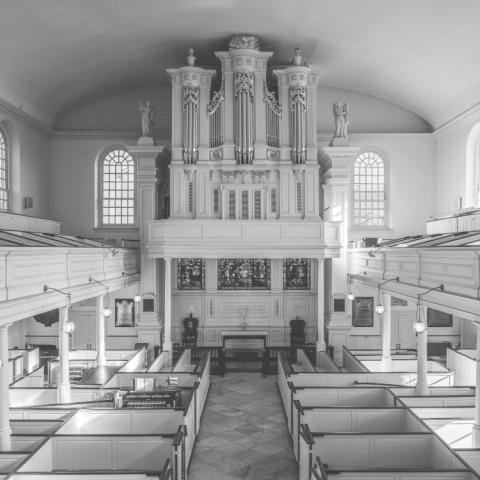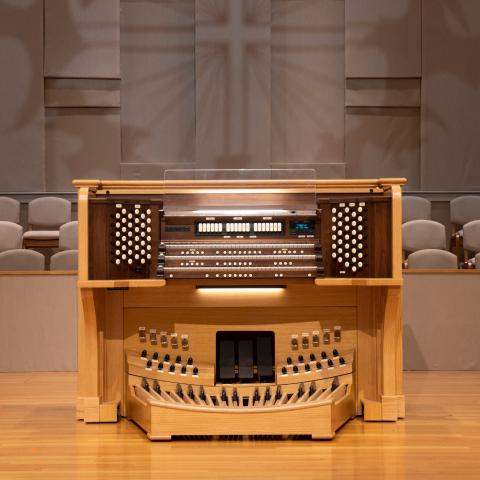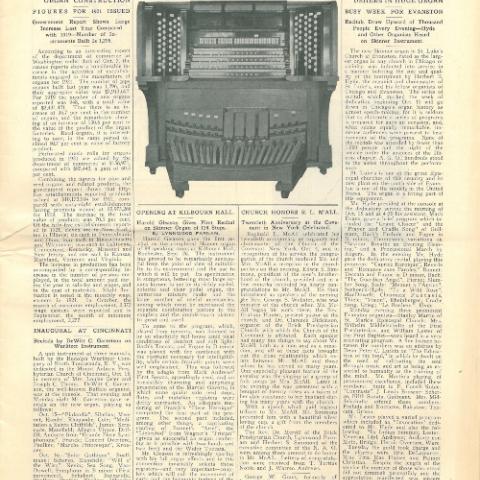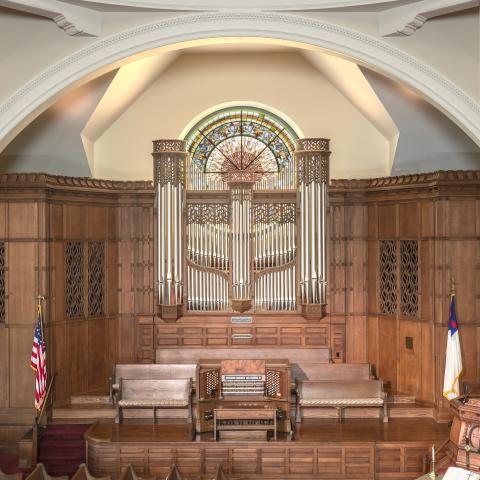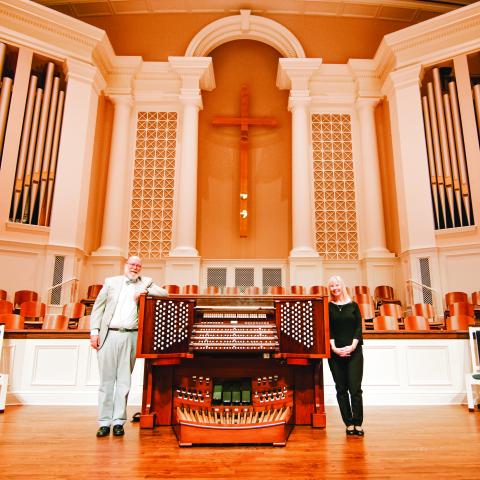A. Thompson-Allen Company, LLC, New Haven, Connecticut;
Blessed Sacrament Catholic Church, Worcester, Massachusetts

From the builder
Having tuned and maintained the organ for about ten years, we had a good idea of what was needed to get the organ back into first class condition. There were a number of dead notes, and the organ would not stay in tune. The organ had survived remarkably well, having very little work done to it since 1928 when it was installed as Skinner Organ Company Opus 736.
Normal wear and tear combined with some water damage from the tower made it clear the time had come to give the organ a full restoration to its original condition. Before this could happen, the organ’s environment had to be addressed. There were three covered windows within the chamber that were collapsing, leaking, and drafty. These could only be repaired by first removing the entire instrument. We did so in 2017, and while all of the components of the organ were in our shop in New Haven, Connecticut, we fully restored the organ without any changes to the pipes or the chassis. All of the perishable materials in the organ mechanism have been fully replaced. Skinner organs are world famous for being the very finest that money could buy, and Opus 736 is no exception. Now restored, its beauty of tone can again be fully appreciated. It truly is a masterpiece!
The windows have been fully restored, and the Saint Cecilia window in the tower has been fitted with LED lights so that it can be seen from the outside of the church. This window had been sealed up since the organ was installed in 1928. The two side windows, which were plain glass, have been removed and filled in with matching stone. The roof and tower have all been properly repaired to keep the interior of the church and the organ dry and free from plaster debris.
The interior of the organ chamber has been repaired and fully painted. New work lights have been installed as well. The oak case and pipes, which had been painted the same color as the wall, have been fully restored to their original appearances. The original blower has been restored by Joseph Sloane with a new three-phase motor.
This beautiful instrument is now ready for another ninety to one-hundred years of service, at which time, this can all be done again. The organ is so well designed and constructed out of the very finest materials that it can be renewed over and over.
The rededication recital of the organ was performed by Thomas Murray on October 6. Professor Murray is a very well-known organist and expert on Skinner organs, having held the position of university organist at Yale University for the last thirty-eight years. Yale is home to the incredible 12,600-pipe Skinner organ from 1928 in Woolsey Hall, Opus 722.
The restoration could not have happened without the full support of the Diocese of Worcester, Elizabeth Noone (director of music), Father Richard Trainor, The Bradley Foundation, Broome and Company, LLC, Royal Finishing Company, and the members of Blessed Sacrament Church.
Please visit our website for a detailed specification of the organ.
We at the A. Thompson-Allen Company are very grateful for the opportunity to renew this superb instrument.
—Nicholas Thompson-Allen, Co-Director
A. Thompson-Allen Company, LLC
Curators of Organs at Yale University
Pipe Organ Maintenance and Restoration
From the organist
On first visiting the Opus 736 Skinner, Nicholas Thompson-Allen remarked that it was in pristine condition for restoration. The organ had been maintained throughout its history, but nothing had ever been altered.
A complete, historic restoration seemed like a dream. It is now a dream realized.
The quality of the original construction was such that, though clearly in need of restoration, the instrument was playable and in continuous use right up until its removal to New Haven.
The first time I played the fully restored instrument I was astounded! I expected the sound to be cleaner and brighter. I did not expect to feel that I was hearing the instrument for the first time!
The genius of E. M. Skinner’s tonal design is now fully apparent, everything is balanced and suitable to the space, from the magnificent 16′ Waldhorn in the Swell to the delicacy of the string combination in the Choir. The full tonal spectrum can now be heard. All of the voicing was done using the specifications original to this specific instrument, so we truly have a sense of what it sounded like in 1928. I find the results comparable to the restoration of an old master’s painting: it was already wonderful, but restoration brings to light a whole new world of beauty.
Professor Thomas Murray’s October 6 re-dedication recital was truly a joyous, celebratory event.
The instrument is a delight to play and we look forward to its music in service to the parish and concert use for years to come.
We at Blessed Sacrament are so grateful to everyone at the A. Thompson-Allen Co., the Joseph Bradley Foundation, and all those who worked on this project.
—-Elizabeth Noone, Organist and Director of Music
Blessed Sacrament Church
From the pastor
Liturgy is the work of the people. The work of all the people that brought about the total restoration of our E. M. Skinner organ reminded me of the craft guilds of the Middle Ages in Europe. At the level of Master Craftman was the hallmark of these workers who restored the wonderful warm sounds of this instrument. Our Faith Community now makes an even more “Joyful sound unto the Lord.”
—Rev. Richard F. Trainor, Pastor
Blessed Sacrament Catholic Church, Worcester, Massachusetts
Builder’s website:
Church website: blessedsacrament.us
GREAT ORGAN (Manual II)
16′ Bourdon (Pedal, 56 pipes; 5 pipes)
8′ First Diapason (43 scale, 1/4 mouth, linen lead, 2′ C = 6)
8′ Second Diapason (45 scale, 1/5 mouth, linen lead, 2′ C = 7)
8′ Flute Harmonique (“new” scale, Cavaillé-Coll type, spotted metal, 2′ C = 9)
4′ Octave (58 scale, 1/5 mouth, linen lead, 2′ C scant 7)
II Grave Mixture (C-11, 1/5 mouth spotted metal, 22⁄3′ 53 scale, scant 9; 2′ C 50 scale, scant 9)
CHOIR ORGAN (Manual I, enclosed, vertical shutters)
8′ Concert Flute (“new” scale, C1–B12 stopped wood; C13–B36 open wood; C37–C61 harmonic metal; C#62–C73 not harmonic, all plain metal)
8′ Dulciana (56 scale,1/5 mouth, zinc and spotted metal, 2′ C = 13)
8′ Unda Maris (TC; same as Dulciana)
4′ Flute (#2 harmonic flute, plain metal, harmonic at middle C, 2′ C = 10)
8’ Clarinet (common)
Tremolo
SWELL ORGAN (Manual III, enclosed, horizontal shutters)
8′ Diapason (46 scale, 1/4 mouth, spotted metal, 2′ C = strong 8)
8′ Rohrflöte (common, Willis III type, wood and stopped plain metal with bored stoppers)
8′ Salicional (60 scale, 1/5 mouth, spotted metal, 2′ C = 14, soft on account of no Flute Celeste)
8′ Voix Celeste (CC, same as Salicional)
4′ Octave (60 scale, 1/5 mouth, linen lead, 2′ C = 8)
4′ Flute Triangulaire (common, 2′ C = 11)
III Mixture (C-14, 1/5 mouth, spotted metal, 15-19-22)
C–A 15 – 19 – 22 = 22 notes 8 – 15 – 22 50 scale
A#–F 12 – 15 – 19 = 20 notes 12 – 19 52 scale
F#–C 8 – 12 – 15 = 19 notes
61 notes
16′ Waldhorn (common, English)
8′ Trumpet (common, English)
8′ Oboe (common, bells with no caps)
Tremolo
PEDAL ORGAN
16′ Diapason (common)
16′ Contre Basse (common)
16′ Bourdon (common)
8′ Octave (ext 16′ Diapason)
8′ Gedeckt (ext 16′ Bourdon)
4′ Flute (ext 16′ Bourdon)
PEDAL COUPLERS
Great to Pedal
Swell to Pedal
Choir to Pedal
Swell to Pedal 4
UNISON COUPLERS
Swell to Great
Choir to Great
Swell to Choir
OCTAVE COUPLERS
Swell to Great 16
Swell to Great 4
Swell to Choir 16
Swell to Choir 4
Choir to Great 16
Choir to Great 4
Choir 16
Choir 4
Swell 16
Swell 4
DIVISIONAL PISTONS
Swell 6
Great 4
Choir 4
Pedal 4
MISCELLANEOUS CONTROLS
General Cancel
Sforzando reversible
Great to Pedal reversible
Pedal to Manual on Great
Pedal to Manual on Swell
Pedal to Manual on Choir
Set
23 stops, 26 ranks, 1,696 pipes

